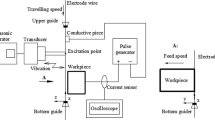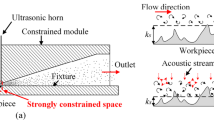Abstract
The morphology of the molten pool plays a crucial role in determining the surface quality of components during laser polishing of 304 stainless steel. Lens ultrasonic vibration significantly impacts the formation of the molten pool during ultrasonic vibration-assisted laser polishing. In this paper, experimental and numerical simulations were applied to investigate the surface properties of ultrasonic vibration-assisted laser polishing. A comparison was conducted between traditional laser polishing and ultrasonic vibration-assisted laser polishing in terms of the difference in peak temperature of the molten pool. The molten pool morphology obtained from the simulation is compared with the experiment results to verify the accuracy of the established model. Consequently, the model exhibits high precision and versatility, allowing for flexibility applied to laser polishing of other systems or materials. The dynamic changes of the temperature field, force field, and velocity field in the molten pool were discussed in detail to reveal the mechanism by which ultrasonic vibration influences. This research work contributes to understanding and guiding the surface formation during ultrasonic vibration-assisted laser polishing of 304 stainless steel.












Similar content being viewed by others
Data availability
No data was used for the research described in the article.
References
Tao N, Chen G, Yu T, Li W, Fan L (2020) Dual-beam laser drilling process for thick carbon fiber reinforced plastic composites plates. J Mater Process Technol 281:116590. https://doi.org/10.1016/j.jmatprotec.2020.116590
Shin JH, Noh HC, Park GD (2023) Effect of spiral welding path and laser power on weld in laser welding of aluminum tab for lithium-ion battery. Int J Adv Manuf Technol 126(3–4):1317–1327. https://doi.org/10.1007/s00170-023-11225-3
Wang Q, Wang H (2022) Fabrication of textured surface with controllable wettability via laser-thermal hybrid processing. Mater Lett 315:131954. https://doi.org/10.1016/j.matlet.2022.131954
Ke W, Zeng W, Oliveira JP, Peng B, Shen J, Tan C, Song X, Yan W (2023) Heat transfer and melt flow of keyhole, transition and conduction modes in laser beam oscillating welding. Int J Heat Mass Transf 203:123821. https://doi.org/10.1016/j.ijheatmasstransfer.2022.123821
Boujelbene M, Ezeddini S, Ben Said L, Bayraktar E, Alhadri M, Aich W, Ghachem K, Kolsi L (2023) Analysis of surface integrity of intermetallic composite based on titanium-aluminum machined by laser cutting. Opt Laser Technol 161:109187. https://doi.org/10.1016/j.optlastec.2023.109187
Bax B, Rajput R, Kellet R, Reisacher M (2018) Systematic evaluation of process parameter maps for laser cladding and directed energy deposition. Addit Manuf 21:487–494. https://doi.org/10.1016/j.addma.2018.04.002
Yao M, Kong F, Tong W (2023) A 3D finite element analysis of thermally induced residual stress distribution in stainless steel coatings on a mild steel by laser hot wire cladding. Int J Adv Manuf Technol 126:759–776. https://doi.org/10.1007/s00170-023-11155-0
Ma CP, Guan YC, Zhou W (2017) Laser polishing of additive manufactured Ti alloys. Opt Lasers Eng 93:171–177. https://doi.org/10.1016/j.optlaseng.2017.02.005
Li K, Zhou H, Zhao Z, Zhou H, Yin J, Jin J (2021) A study on transient molten pool dynamics in laser polishing of Ti6Al4V using numerical simulation. J Manuf Process 65:478–490. https://doi.org/10.1016/j.jmapro.2021.03.045
Yung KC, Xiao TY, Choy HS, Wang WJ, Cai ZX (2018) Laser polishing of additive manufactured CoCr alloy components with complex surface geometry. J Mater Process Technol 262:53–64. https://doi.org/10.1016/j.jmatprotec.2018.06.019
Ramos-Grez JA, Bourell DL (2004) Rducing surface roughness of metallic freeform-fabricated parts using non-tactile finishing methods. Int J Mater Prod Tec 21:297–316. https://doi.org/10.1504/IJMPT.2004.004944
Ukar E, Lamikiz A, López de Lacalle LN, Pozo D, Arana JL (2010) Laser polishing of tool steel with CO2 laser and high-power diode laser. Int J Mach Tools Manuf 50:115–125. https://doi.org/10.1016/j.ijmachtools.2009.09.003
Ma C, Vadali M, Li X, Duffie NA, Pfefferkorn FE (2014) Analytical and experimental investigation of thermocapillary flow in pulsed laser micropolishing. J Micro Nano-Manufacturing 2:1–8. https://doi.org/10.1115/1.4027433
Ma C, Vadali M, Duffie NA, Pfefferkorn FE, Li X (2013) Melt pool flow and surface evolution during pulsed laser micro polishing of Ti6Al4V. J Manuf Sci Eng 135:1–8. https://doi.org/10.1115/1.4025819
Mohajerani S, Miller JD, Tutunea-Fatan OR, Bordatchev EV (2017) Thermo-physical modelling of track width during laser polishing of H13 tool steel. Procedia Manuf 10:708–719. https://doi.org/10.1016/j.promfg.2017.07.026
Shen H, Pan Y, Zhou J, Yao Z (2017) Forming mechanism of bump shape in pulsed laser melting of stainless steel. J Heat Transfer 139:1–10. https://doi.org/10.1115/1.4035710
Zhang C, Zhou J, Shen H (2017) Role of capillary and thermocapillary forces in laser polishing of metals. J Manuf Sci Eng Trans ASME 139:1–11. https://doi.org/10.1115/1.4035468
Liu Y, Geng D, Zhang D, Zhai Y, Liu L, Sun Z, Shao Z, Zhang M, Jiang X (2023) Cutting performance and surface integrity for rotary ultrasonic elliptical milling of Inconel 718 with the ball end milling cutter. J Mater Process Technol 319:118094. https://doi.org/10.1016/j.jmatprotec.2023.118094
Sun Z, Geng D, Zheng W, Liu Y, Liu L, Ying E, Jiang X, Zhang D (2023) An innovative study on high-performance milling of carbon fiber reinforced plastic by combining ultrasonic vibration assistance and optimized tool structures. J Mater Res Technol 22:2131–2146. https://doi.org/10.1016/j.jmrt.2022.12.054
Kang B, Woo Kim G, Yang M, Cho SH, Park JK (2012) A study on the effect of ultrasonic vibration in nanosecond laser machining. Opt Lasers Eng 50:1817–1822. https://doi.org/10.1016/j.optlaseng.2012.06.013
Alavi SH, Harimkar SP (2019) Effect of vibration frequency and displacement on melt expulsion characteristics and geometric parameters for ultrasonic vibration-assisted laser drilling of steel. Ultrasonics 94:305–313. https://doi.org/10.1016/j.ultras.2018.08.012
Alavi SH, Harimkar SP (2015) Melt expulsion during ultrasonic vibration-assisted laser surface processing of austenitic stainless steel. Ultrasonics 59:21–30. https://doi.org/10.1016/j.ultras.2015.01.013
Charee W, Tangwarodomnukun V, Dumkum C (2016) Ultrasonic-assisted underwater laser micromachining of silicon. J Mater Process Technol 231:209–220. https://doi.org/10.1016/j.jmatprotec.2015.12.031
Zhou S, Ma G, Dongjiang W, Chai D, Lei M (2018) Ultrasonic vibration assisted laser welding of nickel-based alloy and Austenite stainless steel. J Manuf Process 31:759–767. https://doi.org/10.1016/j.jmapro.2017.12.023
Wang Y, Li B, Huang L, Cao H, Ren N (2021) Photoelectric property enhancement of Ag/FTO thin films by fabricating antireflection grating structures using ultrasonic-vibration-assisted laser irradiation. Appl Surf Sci 541:148449. https://doi.org/10.1016/j.apsusc.2020.148449
Yang Z, Zhu L, Wang S, Ning J, Dun Y, Meng G, Xue P, Xu P, Xin B (2021) Effects of ultrasound on multilayer forming mechanism of Inconel 718 in directed energy deposition. Addit Manuf 48:102462. https://doi.org/10.1016/j.addma.2021.102462
Zhu L, Yang Z, Xin B, Wang S, Meng G, Ning J, Xue P (2021) Microstructure and mechanical properties of parts formed by ultrasonic vibration-assisted laser cladding of Inconel 718. Surf Coatings Technol 410:126964. https://doi.org/10.1016/j.surfcoat.2021.126964
Zheng Q, Mei X, Jiang G, Cui J, Fan Z, Wang W, Yan Z, Guo H, Pan A (2023) Investigation on ultrasonic vibration-assisted femtosecond laser polishing of C/SiC composites. J Eur Ceram Soc 43:4656–4672. https://doi.org/10.1016/j.jeurceramsoc.2023.03.043
Shao TM, Hua M, Tam HY, Cheung EHM (2005) An approach to modelling of laser polishing of metals. Surf Coatings Technol 197:77–84. https://doi.org/10.1016/j.surfcoat.2005.01.010
Tan P, Kiran R, Zhou K (2021) Effects of sub-atmospheric pressure on keyhole dynamics and porosity in products fabricated by selective laser melting. J Manuf Process 64:816–827. https://doi.org/10.1016/j.jmapro.2021.01.058
Ogoke F, Farimani AB (2021) Thermal control of laser powder bed fusion using deep reinforcement learning. Addit Manuf 46:102033. https://doi.org/10.1016/j.addma.2021.102033
Roberts IA, Wang CJ, Esterlein R, Stanford M, Mynors DJ (2009) A three-dimensional finite element analysis of the temperature field during laser melting of metal powders in additive layer manufacturing. Int J Mach Tools Manuf 49:916–923. https://doi.org/10.1016/j.ijmachtools.2009.07.004
Willis D A, Xu X (1998) Transport phenomena and droplet formation during pulsed laser micro-machining of thin films. ASME Int Mech Eng Congr Expo Proc 1998-P 173–181. https://doi.org/10.1115/IMECE1998-0703
Xu J, Zou P, Kang D, Wang W, Wang A (2022) Research on the formation mechanism of the surface structure in transition regime of laser polishing 304 stainless steel. Opt Laser Technol 149:107906. https://doi.org/10.1016/j.optlastec.2022.107906
Meng X, Artinov A, Bachmann M, Rethmeier M (2019) Numerical and experimental investigation of thermo-fluid flow and element transport in electromagnetic stirring enhanced wire feed laser beam welding. Int J Heat Mass Transf 144:118663. https://doi.org/10.1016/j.ijheatmasstransfer.2019.118663
Li N, Li Z, Kang M, Zhang J (2019) Numerical simulation and experimental study on laser micromachining of 304L stainless steel in ambient air. Int J Heat Mass Transf 140:978–991. https://doi.org/10.1016/j.ijheatmasstransfer.2019.06.051
Kang D, Zou P, Wu H, Wang W, Xu J (2021) Research on ultrasonic vibration-assisted laser polishing of the 304 stainless steel. J Manuf Process 62:403–417. https://doi.org/10.1016/j.jmapro.2020.12.009
Kang D, Zou P, Wu H, Wang W, Xu J (2020) Theoretical and experimental study of ultrasonic vibration-assisted laser polishing 304 stainless steel. IEEE Access 8:206146–206163. https://doi.org/10.1109/ACCESS.2020.3036403
Zhang W, Roy GG, Elmer JW, DebRoy T (2003) Modeling of heat transfer and fluid flow during gas tungsten arc spot welding of low carbon steel. J Appl Phys 93:3022–3033. https://doi.org/10.1063/1.1540744
Cho J H, Farson D F, Milewski J O, Hollis K J (2009) Weld pool flows during initial stages of keyhole formation in laser welding. J Phys D Appl Phys 42. https://doi.org/10.1088/0022-3727/42/17/175502
Acknowledgements
This work was supported by the National Natural Science Foundation of China [Grant number 51875097], the Fundamental Research Funds for the Central Universities [Grant numbers N2103006, N2203001], and the National High-end Foreign Experts Recruitment Plan [Grant number G2021128002L].
Author information
Authors and Affiliations
Contributions
Di Kang: conceptualization, methodology, and writing—review and editing. Ping Zou: formal analysis and supervision. Jilin Xu: software and formal analysis.
Corresponding author
Ethics declarations
Competing interests
The authors declare that they have no known competing financial interests or personal relationships that could have appeared to influence the work reported in this paper.
Additional information
Publisher's Note
Springer Nature remains neutral with regard to jurisdictional claims in published maps and institutional affiliations.
Rights and permissions
Springer Nature or its licensor (e.g. a society or other partner) holds exclusive rights to this article under a publishing agreement with the author(s) or other rightsholder(s); author self-archiving of the accepted manuscript version of this article is solely governed by the terms of such publishing agreement and applicable law.
About this article
Cite this article
Kang, D., Zou, P. & Xu, J. Mechanism and numerical simulation analysis of ultrasonic vibration-assisted laser polishing 304 stainless steel. Int J Adv Manuf Technol 130, 603–621 (2024). https://doi.org/10.1007/s00170-023-12728-9
Received:
Accepted:
Published:
Issue Date:
DOI: https://doi.org/10.1007/s00170-023-12728-9




